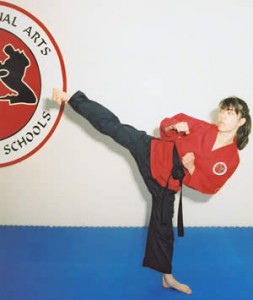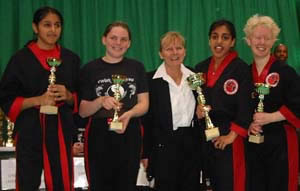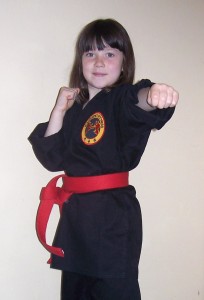Getting Girls and Women to Practice Taekwondo
I have no doubts most genuine, caring, instructor can see the value of teaching young members of our society lessons, both physically and mentally, through the martial arts. But are we reaching out to all children, or are there some children missing out? Research within the physical education field indicates strongly that amongst children, there are a greater number of boys participating in physical activity compared to girls. This gets worse as girls hit their teens. Therefore gender in itself is considered a determinant of physical activity. Within the martial arts school a similar pattern may be dominant with young children.
 Some researchers argue that this gender difference may not necessary be biological but a result of ‘cultural forces’. In other words, the availability of activities in general may be inclined towards boys, even though there has been increasing opportunities and acceptance for girls physical activity. Another perspective is the ‘socialization perspective’, defined as ‘The lifelong process by which the individual acquires the attitudes, beliefs, customs, values, roles and expectations of a culture or a social group’. It may be that martial arts like Taekwondo still have the perception of being a ‘masculine’ activity. Could it be that the various structures of society in the development of habits of physical activity, for example, parents, peers, school and neighbourhood may only encourage little boys to participate in what is considered masculine activities such as football and martial arts whereas little girls are encouraged to do disco dancing or ballet to be socially acceptable? At another level, the local community martial arts club or sports centre may put out advertising or flyers that typically have the endearing picture of a little boy in his uniform, an image that only little boys or parents of little boys may identify with.
Some researchers argue that this gender difference may not necessary be biological but a result of ‘cultural forces’. In other words, the availability of activities in general may be inclined towards boys, even though there has been increasing opportunities and acceptance for girls physical activity. Another perspective is the ‘socialization perspective’, defined as ‘The lifelong process by which the individual acquires the attitudes, beliefs, customs, values, roles and expectations of a culture or a social group’. It may be that martial arts like Taekwondo still have the perception of being a ‘masculine’ activity. Could it be that the various structures of society in the development of habits of physical activity, for example, parents, peers, school and neighbourhood may only encourage little boys to participate in what is considered masculine activities such as football and martial arts whereas little girls are encouraged to do disco dancing or ballet to be socially acceptable? At another level, the local community martial arts club or sports centre may put out advertising or flyers that typically have the endearing picture of a little boy in his uniform, an image that only little boys or parents of little boys may identify with.
 Another theory is related to ‘sex role patterns’. This is similar to the paragraph above, whereby boys and girls are socialised into different roles form an early age. The masculine role is to be competitive and perform and the feminine role is to be family orientated and expressive. Thus young boys would naturally be attracted to competitive sporting activities which demand high levels of achievement. There are gender differences in motivation of children where by boys, particularly of a younger age group endorse competition and girls endorse recreation. Competition and performance can typically be the emphasis in more traditional martial arts thus being more attractive to boys. Male instructors
Another theory is related to ‘sex role patterns’. This is similar to the paragraph above, whereby boys and girls are socialised into different roles form an early age. The masculine role is to be competitive and perform and the feminine role is to be family orientated and expressive. Thus young boys would naturally be attracted to competitive sporting activities which demand high levels of achievement. There are gender differences in motivation of children where by boys, particularly of a younger age group endorse competition and girls endorse recreation. Competition and performance can typically be the emphasis in more traditional martial arts thus being more attractive to boys. Male instructors themselves may subconsciously emit these messages, or use a teaching style that encourages this behaviour. From personal observation, it seems some martial arts classes, taught long-term by female instructors, appear to have more girls in them than those taught by the male instructors. Perhaps female role-modelling could also account for this.
themselves may subconsciously emit these messages, or use a teaching style that encourages this behaviour. From personal observation, it seems some martial arts classes, taught long-term by female instructors, appear to have more girls in them than those taught by the male instructors. Perhaps female role-modelling could also account for this.
According to other psychological theories, boys have a higher perceived competence than girls and this is particularly noticeable around age 11. The perceived lack of competence felt by girls may result in girls being less interested in martial arts activities in the first place, therefore less keen to join. Therefore care must be taken in recruitment and beginners’ syllabus to ensure the children are encouraged at that critical stage.
So how can martial arts instructors attract more young girls & women into Taekwondo?
- Educate society about the benefits of martial arts for all children, male and female, in that it is not just about kicking and punching, rough and tumble, but about character development, health education, an enjoyable physical activity suitable for both sexes. This can be done by re-enforcing the parents of existing customers and giving them the message that this activity is highly beneficial for young girls. Visit other members of the community with this message such as schools, especially primary schools, girls schools, giving talks, seminars, at assemblies or any other community venue.
- Use marketing material (flyers, adverts, posters that has more pictures of little girls in action and choose words carefully on the advertising that avoid elitism (a picture of a child performing an impossible kick) or competition (picture of two boys in a sparring match).
- Re-design the children’s curriculum and use a teaching style that places little emphasis on traditionalism, elitism, performance and competition. The goal should be participation and enjoyment. The beginners’ syllabus should be simple so that the beginner child can visibly see that they are able to meet the belt requirements without too much difficulty, thus breaking down any barriers related to perceived competence.
- Offer perhaps a females only class, or a cardio-kickboxing class. It has been my experience that many women will do this activity first and then build up confidence to join a more traditional style martial arts class.
- If at all possible, try to encourage female instructors or assistant instructors to be involved in the club, who can be important role models for some of these children.




